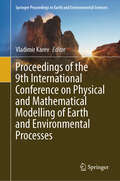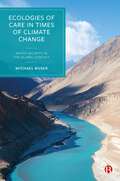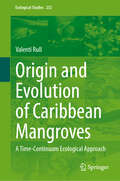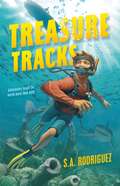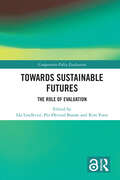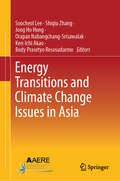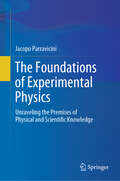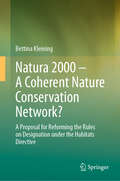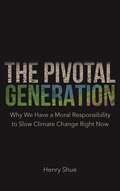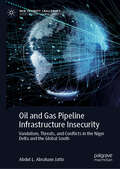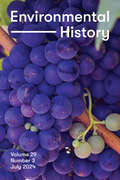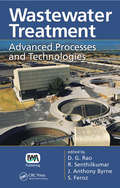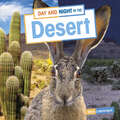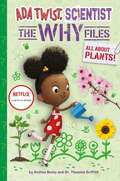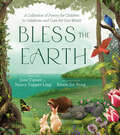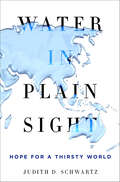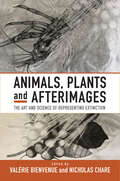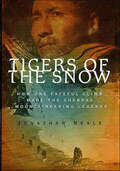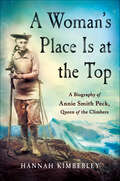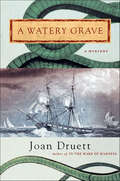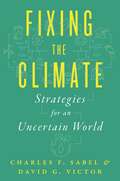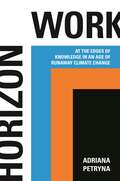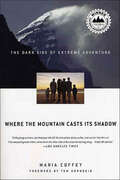- Table View
- List View
Proceedings of the 9th International Conference on Physical and Mathematical Modelling of Earth and Environmental Processes (Springer Proceedings in Earth and Environmental Sciences)
by Vladimir KarevThis book presents short papers of participants of the 9th International Scientific Conference-School for Young Scientists «Physical and Mathematical Modeling of Earth and Environment Processes. A special focus is given to the extraction of hydrocarbon resources, including from unconventional sources. An alternative to the use of hydrocarbons as a main source of energy on the Planet in the coming decades is unlikely to be found. At the same time, the resource base of hydrocarbons is quickly depleted, in particularly, large and accessible oil and gas fields. The shale oil and gas, Arctic hydrocarbon stocks, gas hydrates, coal bed methane, oil and gas from deep horizons can become new sources. "Deep oil" may be the most promising source of expanding the resource base of hydrocarbons according to many experts. New technologies are required to their development. Efficient low-cost technologies can be created on the basis of geomechanical approach, i.e., through the use of a huge elastic energy stored in the rock massif due to rock pressure. The creation of new breakthrough approaches to the development of hydrocarbon fields is very important in today's geopolitical conditions and requires the involvement of young minds and strength. International activities, including the youth scientific schools, can become an effective tool for exchange of information and the organizing of interdisciplinary research of processes in geo-environment. The book presents the new results of the experimental and theoretical modeling of deformation, fracture, and filtration processes in the rocks in connection to issues of creating scientific fundamentals for new hydrocarbon production technologies. The investigations of the dependence of well stability and permeability of rocks on the stress-strain state in conditions of deep horizons and high rock pressure are also represented.
Ecologies of Care in Times of Climate Change: Water Security in the Global Context
by Michael BuserThis book investigates and analyses places in Europe, North America and Asia that are facing the immense challenges associated with climate change adaptation. Presenting real-world cases in the contexts of coastal change, drinking water and the cryosphere, Michael Buser shows how the concept of care can be applied to water security and climate adaptation. Exploring the everyday and often hidden ways in which water security is accomplished, the book demonstrates the pervasiveness and power of care to contribute to flourishing lives and communities in times of climate change.
Origin and Evolution of Caribbean Mangroves: A Time-Continuum Ecological Approach (Ecological Studies #252)
by Valentí RullThis book provides a comprehensive, detailed, and coherent spatio-temporal account of Caribbean mangrove evolution from its evolutionary origins to the present that is not available for any mangrove region in the world. Mangroves are intertidal wetland forests that play a crucial role in the maintenance of terrestrial and marine biodiversity, and in the functioning of global biogeochemical cycles (especially the carbon cycle). These ecosystems dominate the tropical/subtropical coasts of all continents and are among the most threatened ecosystems in the world. This book combines all temporal scales, from the geological to the ecological, to provide an integrated picture of mangrove history and the natural and anthropogenic drivers of ecological and evolutionary change. This may be useful not only for understanding the current ecological status of these emblematic ecosystems, but also for informing their conservation in the face of ongoing global change.
Treasure Tracks
by S.A. RodriguezA debut middle-grade adventure about a young teen who goes on a treasure hunt for undersea riches to help his ailing abuelo.Twelve-year-old Fernando “Fin” joins his grandfather on a secret quest to find a long-lost treasure swept to sea. But when their first mission takes a near-deadly turn, leaving his abuelo weak and unable to speak, Fin’s left to navigate the hunt alone. Well, not exactly alone—his boring, totally unadventurous dad agrees to help out. With danger lurking at every turn, Fin dives into the mission in order to save Abuelo's life. But between Dad’s constant worrying, unwanted diving babysitters, and harrowing encounters in the deep sea, the boy finds himself in a race against time to locate the treasure. If he can’t succeed? He fears he might lose Abuelo for good.S.A. Rodriguez's Treasure Tracks is a fast-paced story filled with heart and humor about the bonds of family, the meaning of a legacy, and most of all, the discovery of true treasure.
Towards Sustainable Futures: The Role of Evaluation (Comparative Policy Evaluation)
by Kim Forss Ida Lindkvist Per Øyvind BastøeTowards Sustainable Futures serves as a guide to better understand what roles evaluation can play in sustainability. Rather than proposing a single definition of sustainability or methodological approach, this book gives us the tools to improve the quality and relevance of evaluation of sustainability. Divided into two parts, the first part introduces the reader to key debates and challenges related to evaluation of sustainability. Part Two provides examples of methods and applications. By combining a stellar line up of specialists, theorists, and practitioners in the field of development evaluation with expert, accessible and engaged analysis of key issues, Towards Sustainable Futures is a must-read source for re-tooling and re-focussing evaluation towards the green transition imperative. It should be essential reading for scholars and practitioners of evaluation.Chapters 1, 4, 6 and 15 of this book are freely available as a downloadable Open Access PDF at http://www.taylorfrancis.com under a Creative Commons [Attribution-Non Commercial-No Derivatives (CC-BY-NC-ND)] 4.0 license.
Energy Transitions and Climate Change Issues in Asia
by Soocheol Lee Ken-Ichi Akao Budy Prasetyo Resosudarmo Shiqiu Zhang Jong Ho Hong Orapan Nabangchang-SrisawalakThe rapid pace of economic development and urbanization in Asia have led to several major problems such as greenhouse gas emissions, mass consumption, and depletion of natural resources. These problems pose a major threat to a sustainable future for Asia and are hindering many Asian countries' goal of becoming carbon-neutral by the middle of this century. Solving these problems requires a comprehensive understanding of the nature of energy consumption, exploitation of natural resources, and deterioration of the environment.To accelerate the green energy transition and promote efficient resource use in Asia, a range of policy options and joint efforts among Asian countries will be required, including carbon pricing, resource tax reform, the expansion of transition finance, support for the development of low-carbon, and resource-efficient social infrastructure. However, Asia is home to many countries, each in a different stage of economic development and with its own culture and customs. Practical implementation of these policies will require bringing together researchers, policymakers, and citizens to share their knowledge and engage in discussions to generate policy ideas that are appropriate for each country. The purpose of this book is to share theoretical and empirical knowledge and convey policy implications that can be expected to accelerate energy transition and resource use effectiveness toward a sustainable future in Asia.
The Foundations of Experimental Physics: Unraveling the Premises of Physical and Scientific Knowledge
by Jacopo ParraviciniStandard STEM courses, for all of their value, do not tend to include systematic lectures or treatment about the nature of the scientific method. This book aims to provide a wide reflection on the general principles of physics and explore the foundations of scientific knowledge as a whole. The author delves into the study of what lies at the basis of science in general, and physics in particular. Themes such as the relation between natural phenomena and mathematical language are addressed, highlighting the main hubs of conceptual development in science. The volume also examines the conceptual and practical instruments that have been progressively developed to investigate the nature of physics. Furthermore, the author discusses the importance of “scientific practice” within the scientific community, emphasizing its role in advancing knowledge and how it contributes to physics as a whole. Divided into three parts, each covering different aspects of physics and its foundations, the text, while assuming basic knowledge of physics and mathematics taught in university courses, is accessible to all STEM students, and will be useful for anyone looking to gain valuable insights into the nature of physics and the methods used to acquire knowledge in this field.
Natura 2000 – A Coherent Nature Conservation Network?: A Proposal for Reforming the Rules on Designation under the Habitats Directive
by Bettina KleiningThis book offers a fresh perspective on the Habitats Directive's rules on designating Natura 2000 - the European biodiversity conservation network. Although the Habitats Directive came into force in the early 1990s, the network is not yet optimally set up and lacks coherence and connectivity. The author examines the Habitats Directive’s provisions regarding the designation of Natura 2000 and discusses possible reasons for the EU Member States’ ongoing lack of compliance with their designation duties. She reassesses the 2015 REFIT Fitness Check of the Nature Directives to look for the Member States’ reasons for not having optimally complied with their designation duties yet. She then analyses the Habitats Directive to reveal elements of non-optimal drafting in its designation provisions. Sensible law reforms that do not interfere with the general framework of the Habitats Directive and which keep in mind the relevant national, regional, and international biodiversity law and policy,as well as the relevant case law will be discussed to this end. As a result, this book presents an enhanced legal designation framework that can support Member States’ compliance with their designation obligations. The book finally goes beyond the European biodiversity legislation, also shedding light on the effects of the suggested reforms for the broader biodiversity and environmental law and policy landscape, and concludes that reforming the Habitats Directive would benefit a variety of contemporary areas of law. This book targets academics and policy-makers in the field as it provides a scholarly as well as a hands-on approach to the subject of strengthening European biodiversity law.
The Pivotal Generation: Why We Have a Moral Responsibility to Slow Climate Change Right Now
by Henry ShueAn eminent philosopher explains why we owe it to future generations to take immediate action on global warmingClimate change is the supreme challenge of our time. Yet despite growing international recognition of the unfolding catastrophe, global carbon emissions continue to rise, hitting an all-time high in 2019. Unless humanity rapidly transitions to renewable energy, it may be too late to stop irreversible ecological damage. In The Pivotal Generation, renowned political philosopher Henry Shue makes an impassioned case for taking immediate, radical action to combat global warming.Shue grounds his argument in a rigorous philosophical analysis of climate change’s moral implications. Unlike previous generations, which didn’t fully understand the danger of burning carbon, we have the knowledge to comprehend and control rising carbon dioxide levels. And unlike future generations, we still have time to mitigate the worst effects of global warming. This generation has the power, and thus the responsibility, to save the planet. Shirking that responsibility only leaves the next generation with an even heavier burden—one they may find impossible to bear.Written in direct, accessible language, The Pivotal Generation approaches the latest scientific research with a singular moral clarity. It’s an urgently needed call to action for anyone concerned about the planet’s future.
Oil and Gas Pipeline Infrastructure Insecurity: Vandalism, Threats, and Conflicts in the Niger Delta and the Global South (New Security Challenges)
by Abdul L. JattoThis book offers a comprehensive analysis of infrastructure insecurity issues in the historic Niger Delta, drawing on empirical fieldwork involving host communities, regulators, and multinational oil and gas operators. It introduces innovative models and theories, such as a pipeline life cycle model focusing on community development, community neglect aggression displacement theory, social aggression theory, stakeholders’ policy development model, contemporary poor governance cycle model, and an infrastructure insecurity nexus model, linking governance, socio-economic conditions, and infrastructure insecurity in resource-rich regions of the Global South. The book bridges gaps left by previous publications, providing depth and applicability of data. It employs the Frustration- Aggression Displacement theory to explain underlying triggers of violence and uses real-world case studies, diagrams, and charts to facilitate understanding. Suitable and engaging for individuals, communities, or regulators involved in oil and gas activities alike, this book offers valuable insights into onshore pipeline infrastructure insecurity in Nigeria, West Africa, and the broader Global South, addressing regulation, compliance, environmental concerns, social aspects, and technological innovations.
An Invitation to the Botanic Gardens
by Charlotte GuillainGrab your very own VIP access pass and explore the incredible Botanic Gardens.Have you ever wondered what goes on at the Botanic Gardens? It's not all planting and pruning. In fact, the team have a planet-saving mission on their hands – and you can help. Step off the path and follow the Garden crew who will show you behind the scenes of the Botanic Gardens with your very own access-all-areas invitation.Find out how scientists research plants that can cure diseases, watch workers wading in the waterlily pond, and discover the secrets of seeds. Find out why samples of rare and endangered plants are stored in the Herbarium and leave no leaf unturned in the tropical glasshouse. Discover insect-eating plants, zombie fungus, plants pretending to be pebbles, and more.As you turn the pages you'll learn about the importance of insects, the impact of climate change and how plants grow. With beautiful, lush illustrations, you'll discover more wonderful details each time you return to the gardens.Three large gatefolds open up to reveal even more information.
Environmental History, volume 29 number 3 (July 2024)
by Environmental HistoryThis is volume 29 issue 3 of Environmental History. Environmental History (EH) is the world’s leading scholarly journal in environmental history and the journal of record in the field. Scholarship published in EH explores the changing relationships between humans and the environment over time. This interdisciplinary journal brings together insights from geography, anthropology, the natural sciences, and many other disciplines to inform historical scholarship.
Wastewater Treatment: Advanced Processes and Technologies
by R. Senthilkumar D. G. Rao J. Anthony Byrne S. FerozEmphasizing new technologies that produce clean water and energy from the wastewater treatment process, this book presents recent advancements in wastewater treatment by various technologies such as chemical methods, biochemical methods, membrane separation techniques, and nanotechnology. It addresses sustainable water reclamation, biomembrane treatment processes, advanced oxidation processes, and applications of nanotechnology for wastewater treatment. It also includes integrated cost-based design methodologies. Equations, figures, photographs and tables are included within the chapters to aid reader comprehension. Case studies and examples are included as well.
Day and Night in the Desert (Habitat Days and Nights)
by Ellen LabrecqueSpend a day and night in the desert! Learn about this dry habitat through the unique animals that call it home. Stand with meerkats during a watchful hunt for insects. Spot a jackrabbit taking a shaded midday nap. Join a desert tortoise as it dines on colorful cactus fruit. After dark, follow a snake as it slithers in cool, moonlit sand. What will tomorrow bring in the desert?
All About Plants! (Questioneers)
by David Roberts Andrea Beaty Theanne GriffithAll About Plants (Ada Twist, Scientist: The Why Files) is the second book in a nonfiction early reader series based on the Netflix show from New York Times bestselling creator of the Questioneers, Andrea Beaty, and author Theanne Griffith. <P><P> What do plants eat? Why do some plants have flowers and others don’t? And what’s the tallest plant out there? Ada Twist, Scientist: The Why Files is the perfect nonfiction resource for all these questions and more. Based on the bestselling series and the Netflix show, this nonfiction series is perfect for the youngest scientists of tomorrow as they learn along with Ada. Designed in a scrapbook format, these books combine art from the show, illustrations, and photography to bring simple science concepts to life.
Bless the Earth: A Collection of Poetry for Children to Celebrate and Care for Our World
by June Cotner Nancy Tupper LingA beautifully illustrated collection of poems and prayers to help children develop an appreciation for the natural worldBless the Earth, our faithful friend,her mountain range and river bend,her forest green and canopy,the hidden world of bended trees. Bless the Earth shows the miracle of our planet Earth through beautiful imagery and delightful poetry, calling all people, young and old, to care for our wonderful world. This sweet and welcoming anthology for children ages 3-7 knits together our common humanity and the natural world in an engaging way that is simple for young readers to understand.Bless the Earth contains approximately sixty selections of original as well as classic poems, divided into five chapters each:Dreams for My WorldEarth and SkyAll Creatures, Big and SmallSeasonsCaring for Our World Bless the Earth calls us again and again to understand how important it is to care for our world, respect our neighbors—humans, plants, and animals alike—and reimagine a world that is healthy and whole.
Water in Plain Sight: Hope for a Thirsty World
by Judith D. SchwartzWater scarcity is on everyone's mind. Long taken for granted, water availability has entered the realm of economics, politics, and people's food and lifestyle choices. But as anxiety mounts - even as a swath of California farmland has been left fallow and extremist groups worldwide exploit the desperation of people losing livelihoods to desertification - many are finding new routes to water security with key implications for food access, economic resilience, and climate change.Water does not perish, nor require millions of years to form as do fossil fuels. However, water is always on the move. In this timely, important book, Judith D. Schwartz presents a refreshing perspective on water that transcends zero-sum thinking. By allying with the water cycle, we can revive lush, productive landscapes. Like the river in rural Zimbabwe that, thanks to restorative grazing, now flows miles further than in living memory. Or the food forest of oranges, pomegranates, and native fruit-bearing plants in Tucson, grown through harvesting urban wastewater. Or the mini-oasis in West Texas nourished by dew.Animated by stories from around the globe, Water In Plain Sight is an inspiring reminder that fixing the future of our drying planet involves understanding what makes natural systems thrive.
Animals, Plants and Afterimages: The Art and Science of Representing Extinction
by Nicholas Chare Valérie BienvenueThe sixth mass extinction or Anthropocene extinction is one of the most pervasive issues of our time. Animals, Plants and Afterimages brings together leading scholars in the humanities and life sciences to explore how extinct species are represented in art and visual culture, with a special emphasis on museums. Engaging with celebrated cases of vanished species such as the quagga and the thylacine as well as less well-known examples of animals and plants, these essays explore how representations of recent and ancient extinctions help advance scientific understanding and speak to contemporary ecological and environmental concerns.
Tigers of the Snow: How One Fateful Climb Made the Sherpas Mountaineering Legends
by Jonathan NealeTigers of the Snow is true story of the tragedy and survival on one of the world's most dangerous mountains.In 1922 Himalayan climbers were British gentlemen, and their Sherpa and Tibetan porters were "coolies," unskilled and inexperienced casual laborers. By 1953 Sherpa Tenzing Norgay stood on the summit of Everest, and the coolies had become the "Tigers of the Snow."Jonathan Neale's absorbing book is both a compelling history of the oft-forgotten heroes of mountaineering and a gripping account of the expedition that transformed the Sherpas into climbing legends. In 1934 a German-led team set off to climb the Himalayan peak of Nanga Parbat, the ninth highest mountain on earth. After a disastrous assault in 1895, no attempt had been made to conquer the mountain for thirty-nine years. The new Nazi government was determined to prove German physical superiority to the rest of the world. A heavily funded expedition was under pressure to deliver results. Like all climbers of the time, they did not really understand what altitude did to the human body. When a hurricane hit the leading party just short of the summit, the strongest German climbers headed down and left the weaker Germans and the Sherpas to die on the ridge. What happened in the next few days of death and fear changed forever how the Sherpa climbers thought of themselves. From that point on, they knew they were the decent and responsible people of the mountain.Jonathan Neale interviewed many old Sherpa men and women, including Ang Tsering, the last man off Nanga Parbat alive in 1934. Impeccably researched and superbly written, Tigers of the Snow is the compelling narrative of a climb gone wrong, set against the mountaineering history of the early twentieth century, the haunting background of German politics in the 1930s, and the hardship and passion of life in the Sherpa valleys.
A Woman's Place Is at the Top: A Biography of Annie Smith Peck, Queen of the Climbers
by Hannah KimberleyAnnie Smith Peck is one of the most accomplished women of the twentieth century that you have never heard of. Peck was a scholar, educator, writer, lecturer, mountain climber, suffragist, and political activist. She was a feminist and an independent thinker who refused to let gender stereotypes stand in her way. Peck gained fame in 1895 when she first climbed the Matterhorn at the age of forty-five – not for her daring alpine feat, but because she climbed wearing pants. Fifteen years later, she was the first climber ever to conquer Mount Huascarán (21,831 feet) in Peru. In 1911, just before her sixtieth birthday, she entered a race with Hiram Bingham (the model for Indiana Jones) to climb Mount Coropuna. A Woman’s Place Is at the Top: The Biography of Annie Smith Peck is the first full length work about this incredible woman who single-handedly carved her place on the map of mountain climbing and international relations. Peck marched in suffrage parades and became a political speaker and writer before women had the right to vote. She was a propagandist, an expert on North-South American relations, and an author and lecturer contracted to speak as an authority on multinational industry and commerce before anyone had ever thought to appoint a woman as a diplomat. With unprecedented access to Peck’s original letters, artifacts, and ephemera, Hannah Kimberley brings Peck’s entire life to the page for the first time, giving Peck her rightful place in history.
A Watery Grave: A Mystery (Wiki Coffin Mysteries #1)
by Joan DruettThe year is 1838, and after more than ten years in the planning, the famous United States Exploring Expedition is set to launch into uncharted waters from the coast of Virginia. A convoy of seven ships filled with astronomers, mapmakers, naturalists, and the sailors charged with getting them around the world, the "Ex. Ex." is finally underway, with much fanfare.Aboard the convoy as ship's linguist is Wiki Coffin. Half New Zealand Maori and half American, Wiki speaks numerous languages and is expected to help the crew navigate the Pacific islands that are his native heritage. But just before departure Wiki, subject to the unfortunate bigotry of the time, is arrested for a vicious murder he didn't commit.The convoy sails off, but just before the ships are out of reach Wiki is exonerated, set free to catch up with his ship and sail on. The catch: the local sheriff is convinced that the real murderer is aboard one of the seven ships of the expedition, and Wiki is deputized to identify the killer and bring him to justice. Full of the evocative maritime detail and atmosphere that have won her numerous awards for her nonfiction, Joan Druett's A Watery Grave is the mystery debut of a masterful maritime writer.
Fixing the Climate: Strategies for an Uncertain World
by David G. Victor Charles F. SabelSolving the global climate crisis through local partnerships and experimentationGlobal climate diplomacy—from the Kyoto Protocol to the Paris Agreement—is not working. Despite decades of sustained negotiations by world leaders, the climate crisis continues to worsen. The solution is within our grasp—but we will not achieve it through top-down global treaties or grand bargains among nations.Charles Sabel and David Victor explain why the profound transformations needed for deep cuts in emissions must arise locally, with government and business working together to experiment with new technologies, quickly learn the best solutions, and spread that information globally. Sabel and Victor show how some of the most iconic successes in environmental policy were products of this experimentalist approach to problem solving, such as the Montreal Protocol on the ozone layer, the rise of electric vehicles, and Europe’s success in controlling water pollution. They argue that the Paris Agreement is at best an umbrella under which local experimentation can push the technological frontier and help societies around the world learn how to deploy the technologies and policies needed to tackle this daunting global problem.A visionary book that fundamentally reorients our thinking about the climate crisis, Fixing the Climate is a road map to institutional design that can finally lead to self-sustaining reductions in emissions that years of global diplomacy have failed to deliver.
Horizon Work: At the Edges of Knowledge in an Age of Runaway Climate Change
by Adriana PetrynaA new way of thinking about the climate crisis as an exercise in delimiting knowable, and habitable, worldsAs carbon dioxide emissions continue to rise, Earth’s fragile ecosystems are growing increasingly unstable and unpredictable. Horizon Work explores how climate change is disrupting our fundamental ability to project how the environment will act over time, and how these rapidly faltering predictions are colliding with the dangerous new realities of emergency response.Anthropologist Adriana Petryna examines the climate crisis through the lens of “horizoning,” a mode of reckoning that considers unnatural disasters against a horizon of expectation in which people and societies can act. She talks to wildfire scientists who, amid chaotic fire seasons and shifting fire behaviors, are revising predictive models calibrated to conditions that no longer exist. Petryna tells the stories of wildland firefighters who could once rely on memory of previous fires to gauge the behaviors of the next. Trust in patterns has become an occupational hazard. Sometimes, the very concept of projection becomes untenable. Yet if all we see is doom, we will overlook something crucial about the scientific and ethical labor needed to hold back climate chaos. Here is where the work of horizoning begins.From experiments probing our planetary points of no return to disaster ecologies where the stark realities of climate change are being confronted, Horizon Work reveals how this new way of thinking has the power to reverse harmful legacies while turning voids where projection falters into spaces of collective action and recoverable futures.
Where the Mountain Casts Its Shadow: The Dark Side of Extreme Adventure
by Maria CoffeyMaria Coffey's Where the Mountain Casts Its Shadow is a powerful, affecting and important book that exposes the far reaching personal costs of extreme adventure.Without risk, say mountaineers, there would be none of the self-knowledge that comes from pushing life to its extremes. For them, perhaps, it is worth the cost. But when tragedy strikes, what happens to the people left behind? Why would anyone choose to invest in a future with a high-altitude risk-taker? What is life like in the shadow of the mountain? Such questions have long been taboo in the world of mountaineering. Now, the spouses, parents and children of internationally renowned climbers finally break their silence, speaking out about the dark side of adventure.Maria Coffey confronted one of the harshest realities of mountaineering when her partner Joe Tasker disappeared on the Northeast Ridge of Everest in 1982. In Where the Mountain Casts Its Shadow, Coffey offers an intimate portrait of adventure and the conflicting beauty, passion, and devastation of this alluring obsession. Through interviews with the world's top climbers, or their widows and families-Jim Wickwire, Conrad Anker, Lynn Hill, Joe Simpson, Chris Bonington, Ed Viesturs, Anatoli Boukreev, Alex Lowe, and many others-she explores what compels men and women to give their lives to the high mountains. She asks why, despite the countless tragedies, the world continues to laud their exploits.With an insider's understanding, Coffey reveals the consequences of loving people who pursue such risk-the exhilarating highs and inevitable lows, the stress of long separations, the constant threat of bereavement, and the lives shattered in the wake of climbing accidents.
Extraordinary Dogs: Stories from Search and Rescue Dogs, Comfort Dogs, and Other Canine Heroes
by John Schlimm Liz StavrinidesA beautiful photo book showcasing more than 50 heroic dogs "in uniform" and their stories, from photographer Liz Stavrinides and author John Schlimm. Extraordinary Dogs portrays more than fifty working dogs, along with the police officers, firefighters, veterans, and other trained volunteer handlers who serve side-by-side with them. Their moving stories and beautiful photographs are an unprecedented glimpse at Comfort Dogs and Search and Rescue Dogs, along with bomb-detecting TSA dogs and canine ambassadors from across the United States.* The stories of the Lutheran Church Charities K-9 Comfort Dogs take readers behind the scenes of their headlining deployments—such as the Boston Marathon bombing, Superstorm Sandy, and the mass shooting at Marjory Stoneman Douglas High School.* Search and Rescue K-9 teams reveal what it’s really like to travel into the eye of natural disasters, accidents, crime scenes, and the worst terrorist strike in recorded history. * At Washington Dulles International Airport, readers meet several of the Department of Homeland Security’s TSA dogs whose sole job it is to keep the flying public safe from explosives and other dangers.Extraordinary Dogs is both a portrait of what love, hope, courage, and heroism look like in their purest forms and a tribute to the eternal and impactful bonds we forge with our furry friends.
